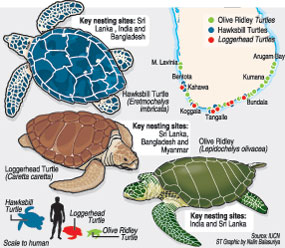A top conservation body has sent out an SOS that almost half the world’s “most threatened sea turtle populations” are found in the northern Indian Ocean, with key nesting sites for some of them being in Sri Lanka.
Five of the most threatened species of sea turtles including Loggerhead Turtles (Caretta caretta), Olive Ridley Turtles (Lepidochelys olivacea) and Hawksbill Turtles (Eretmochelys imbricata) are in the northern Indian Ocean, a study by the Marine Turtle Specialist Group (MTSG) of the International Union for Conservation (IUCN) states.
The key nesting sites for Loggerhead Turtles, Olive Ridley Turtles and Hawksbill Turtles include Sri Lanka, it has been pointed out.
Although the study also identified the “healthiest” sea turtle populations, sadly Sri Lanka was not home to any one of them.
There has been a drop in the numbers of sea turtles, particularly Loggerheads and Hawksbills which come randomly to nest in Sri Lanka, confirmed the Turtle Conservation Project (TCP) Secretary Lalith Ekanayake when contacted by the Sunday Times.
The Hawksbill numbers came down earlier than the others because people were killing them for their colourful shells which were turned into ornamental items, he says, explaining that the drop in the exact numbers of all three species cannot be ascertained because no surveys have been conducted in recent times. The TCP has seen no Hawksbills at all at Rekawa, he lamented, urging that a survey should be carried out at least for one year to get full coverage with regard to nesting sites.
“We see fewer of these three species at our sites in Kosgoda close to Bentota and Rekawa close to Tangalle,” he said, adding that the same could be said of the site monitored by the Department of Wildlife Conservation (DWC) at Bundala. The Olive Ridleys’ nesting period is seasonal while those which come regularly are the Green Turtles (Chelonia mydas).
Explaining that there are seven species of sea turtles all over the world -- Loggerheads, Hawksbills, Leatherbacks (Dermochelys coriacea), Olive Ridleys, Greens, Kemps Ridleys (Lepidochelys kempii) and Flatbacks (Natator depressus), Mr. Ekanayake explains that the first five come to nest in Sri Lanka. The other two, Kemps Ridley and Flatback sea turtles are found only in the Gulf of Mexico and Australia respectively. A sub-species of the Green turtles known as Black turtles is also found only in the Gulf of Mexico.
Referring to the dangers that sea turtles face in Sri Lanka, he said, people still collect their eggs, soon after the turtles lay them and get back to sea. “We have heard that eggs sell for Rs. 10,” he said, adding that when people have economic difficulties, collecting and selling eggs was an easy way out.
Although the law against the slaughter of sea turtles is very tough with fines going up to Rs. 100,000 and the police cracking down heavily, people are still killing them on the sly, he said, pointing out that the other danger is sea turtles getting caught in fishing nets.
The TCP had a rescue programme off Kalpitiya-Kandakuliya, starting in September every year, when Olive Ridleys would be particularly drawn to fishing boats as this is the season for flying fish and they were their delicacy. “We used to accompany the fishing flotillas in a boat and release the sea turtles entangled in the nets,” he said, adding, however, that the rescues have now stopped for lack of funding.
The recent report by MTSG is the first comprehensive status assessment of all sea turtle populations globally and is designed to provide a blueprint for conservation and research, the IUCN stated, adding that the most significant threats are fisheries by-catch, accidental catches of sea turtles by fishermen targeting other species and the direct harvest of turtles or their eggs for food or turtle shell material for commercial use.
“Before we conducted this study, the best we could say about sea turtles was that six of the seven sea turtle species are threatened with extinction globally,” Dr. Bryan Wallace, Director of Science for the Marine Flagship Species at Conservation International (CI) and lead author for the paper has said. “But this wasn’t very helpful for conservation because it didn’t help us set priorities for different populations in different regions. Sea turtles everywhere are conservation-dependent, but this framework will help us effectively target our conservation efforts around the world.”
Green turtles, Leatherbacks dwindling
The nesting numbers of Green turtles have also seen a drastic drop, alerts TCP’s Lalith Ekanayake, explaining that from 1996 to 2010 there has been a decline of 60% at their Rekawa site. Even the Leatherback numbers seem to have dropped, he added. |


